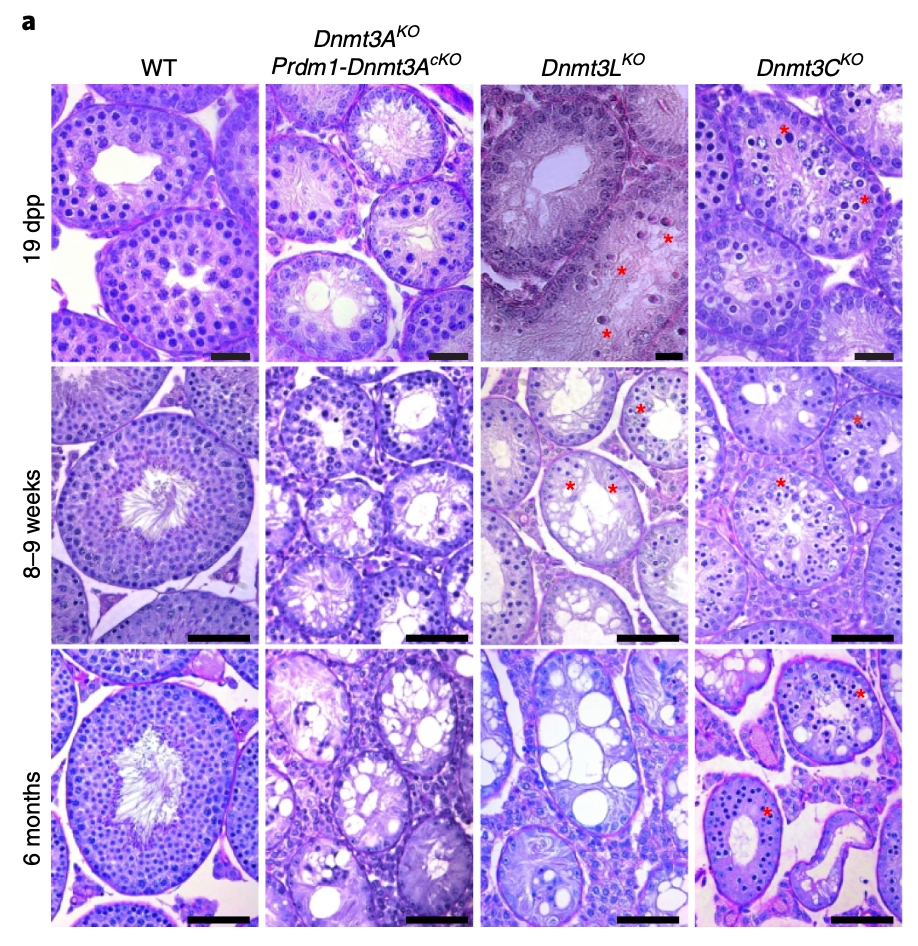We often don’t think of them that way but reproductive cells like sperm and egg are also relatives of stem cells, and it turns out that there are stem cells that make the reproductive cells too like sperm stem cells.

Sperm and germ cell stem cells
DNMT3A-dependent DNA methylation is required for spermatogonial stem cells to commit to spermatogenesis, Nature. It makes sense that DNMT3 would be required for sperm development given the essential role of epigenetics in the process. We previously found a key role for histone H3.3 in sperm development as well. I wonder about a function for H3.3 in sperm stem cells as well.
Rat pups born from sperm artificially produced from stem cells, New Scientist. Similar work has previously been done in mice. It makes you wonder if someday decades down the road researchers will try to make people from gametes produced from stem cells. This could also bring CRISPR into play if someone decides to try to make CRISPR babies again (more on the fate of the scientist who did this in 2018 below). For instance, there are unique challenges to trying to gene-edit embryos precisely and safely. Some probably could be resolved by CRISPR’ing stem cells like sperm stem cells instead.
Unraveling Stem Cells’ Secrets: Immortality of Germline Cells and the Function of “Junk DNA”, SciTechDaily.
More Recommended reads
Chemical reprogramming of human somatic cells to pluripotent stem cells, Nature. This is from a team led by Hongkui Deng. All chemical reprogramming made a big splash in 2013 but that was in mouse cells. Doing it in human cells seems like a big deal.
The creator of the CRISPR babies has been released from a Chinese prison, MIT Tech Review. It’s not often that we hear about scientists going to jail or then later being released from jail but He Jiankui, who made the so-called “CRISPR babies” is reportedly now out of prison. Chinese authorities locked him up not just for gene-editing babies without permission but also for violations of rules in the process.
It’s clearly a different situation, but even here in the U.S. federal authorities have been putting some scientists under investigation, usually for alleged failures to disclose foreign funding.
Somatic mutation rates scale with lifespan across mammals, Nature.
Hearing Loss Can Be Reversed With New Regenerative Therapy, Say MIT Scientists, IFLS.
Editas Medicine Announces Dosing Of First Pediatric Patient In The BRILLIANCE Clinical Trial Of EDIT-101 For LCA10, PR. From the announcement: “Editas Medicine, Inc. (Nasdaq: EDIT), a leading genome editing company, today announced the administration of EDIT-101, an experimental CRISPR gene editing medicine, to the first pediatric patient enrolled in the BRILLIANCE clinical trial, which is designed to test the safety of EDIT-101 for the treatment of Leber congenital amaurosis 10 (LCA10), a CEP290-related retinal degenerative disorder. This marks the world’s first in vivo, or inside the body, dosing of a pediatric patient with a CRISPR gene editing experimental medicine.”
The news about the Hongkui Deng team’s success with chemical reprogramming in human cells is great, but I think that this is a perfect example of why people feel driven to stem cell clinics. The reprogramming in mouse cells was almost 10 years ago. People who desperately need treatments are looking at this with some real anger and hopelessness. They’re asking: HOW is it possible that it took almost a decade just to move to the same process in human beings? Just how many more decades is it going to take before any of this experimentation leads to treatments that we can actually get in a doctor’s office or in a hospital? How can this work be taking so very, very long when we keep hearing about all these great results? I don’t think that anybody can be blamed for asking these questions. But this terrible gap between promising results and anything that can actually be done in the real world is what sends people running to shady stem cell clinics. There has got to be a fundamental change in how the public is informed about this developing technology. Despairing, anguished people have got to have some kind of easy-to-understand scientific explanation, hope, a timeline, SOMETHING besides just these nice results popping up in the media, or stem cell clinics will never stop expanding and taking in money.
No, sperm and eggs are NOT stem cells. The definition of a stem cell is a cell that both can differentiate into later stage cells and self-renew, producing other stem cells. Neither sperm nor eggs can do that. First of all, both are haploid cells. Sperm are derived from earlier stage gametes but they are end-stage cells that do not divide. Eggs are derived from earlier progenitors as well and are not stem cells; all of the oocytes in an adult are pre-formed and non-proliferative unless fertilized. Once fertilized they become diploid and can divide and give rise to stem cells but they are not stem cells themselves as the fertilized egg does not self-renew either.
I see your point, but together they can make an early embryo of totipotent stem cells. I clarified my statement.